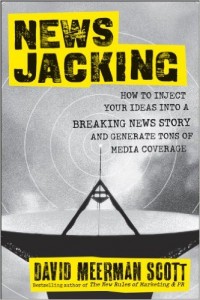
Top 100 Content Marketing Question: How do you keep your content fresh and engaging?
5 ideas to keep content fresh + 3 ideas to keep content engaging

To keep content fresh, perform original research. Research can take several forms:
1. Host a quiz.
Quizzes hook people’s curiosity, as they seek to fill the information gap between your questions and what they know. That’s why game shows are so popular.
People want to find out their knowledge measures up. Do they know more than other people?
Keep your quiz short and sweet: Ask 3 to 5 questions. Offer prizes for the best answers.
After you get enough responses, you can use the quiz results to create content about how people answered. Then share the answers along with your point of view.
2. Survey your audience.

At Tellabs, we surveyed attendees of major trade shows during the first day, asking thought-provoking questions like:
Do you think the Internet will black out or brown out in the next 3 years?”
In fact, nearly half of telecom industry people did expect such a failure. From these survey results, we created a news release overnight and released it on the second day of the show – manufacturing news out of people’s opinions.
3. Hire an expert to study future trends.
Andy Crestodina poses two great questions:
What is the one question in your industry that no one dares to ask?”
“What does everyone in the industry believe, even though there’s no evidence or proof?”
I’d add a third question:
What is the big trend in your industry that no one else sees coming?”
Hire a third-party expert to examine and answer questions about big industry trends. It makes your content more credible. And you borrow the expert’s credibility and audiences.
For example, at Tellabs, we hired a respected industry analyst, Sue Rudd of Strategy Analytics, to study the economics of cellular data networks over the next 3 to 5 years.
At the time, cellular companies were making money hand over fist. Consumers were using more and more cellular data with iPhones and Androids.
Cellular providers were building networks as quickly as possible, to keep pace with demand.
In the midst of boom times, we served up a thought-provoking bad-news story: “The End of Profitability.”

What was the bad news? Customers didn’t want to pay for the amount of data they consumed.
That’s why average revenue per user was flat.With flat revenue and accelerated network construction, the cellular companies would begin losing money in as little as 2 to 3 years.
From the Strategy Analytics study, we created multiple content assets:
- A news release, timed to go out the week before the industry’s top trade show
- A video of Sue explaining the study in 2 minutes
- A magazine article for our customer magazine, Insight
- An infographic
- An executive summary of the study.
In the news release, our digital content assets appeared as a bulleted list — in paragraph two, right after the headline and lead paragraph.
Why? Because the biggest audience for news releases is no longer journalists, it’s customers, investors, employees and consumers.
Our news release gobsmacked customers. Customers who had never before talked to Tellabs started calling – including the chief technology officer’s team at Telefonica and even Google.
At first, many analysts and customers didn’t believe the news. So, we sat down with them and shared the detailed data behind the study. The implications were profound. No doubt many cellular company execs lost sleep, worrying about what to do.
Customers who wanted to see the whole 100-page study in detail could only get it one way: They had to meet face-to-face with a Tellabs salesperson.
Why? We wanted to help sales begin a discussion of how customers could change their networks to stay profitable. For example, they could adopt software-defined networks and network virtualization to reduce costs.
Customers couldn’t resist this thought-provoking story because it scared them. It addressed critical topics such as technology development, future trends, viewpoint and industry news.
As a result, Tellabs’ content marketing program won one of the first Content Marketing Awards from the Content Marketing Institute.

Buyers want to hear about certain topics. A recent BuzzSumo study found that B2B buyers want to read content about:
- Technology development
- Future trends
- Opinion or viewpoint
- Inspirational stories/case studies
- Practical tips and how-to
- Personal career advice
- Research and reference
- Leadership
- Industry news
- In-vogue topics or brands.
What industry trend can you break a news story on?

4. Make news.
In competitive content audits, we find that companies can win a huge share of voice on key topics by focusing on public relations. PR’s work with news media, social media influencers and nonprofit organizations leads to beaucoup content.
For example, HP let journalists into the R&D lab to play with future technologies such as virtual reality backpacks. At the time this news story was written, the company had no market-ready product, no ship date, no price – yet HP generated tons of news coverage — valuable third-party content.
The company’s share of content spiked just because they let reporters into the lab. A brilliant PR move led to great content.
What if your company let journalists play with the products that are only a twinkle in the eyes of your product developers?
When your company has a first-of-its-kind product, work closely with your PR team to generate content. Maybe your news is even big enough to move the product all by itself.
At Ameritech, we took the risk of launching a privacy-protection service solely through news relations.
How’d that work? We met the product’s 2-month sales goal in just 2 weeks. Then, when advertising and promotion were added into the mix, product sales exceeded all expectations.
Never waste a great news story! Make news the tip of your content arrow, follows by content, advertising and promotion to maximize the impact.
5. Hijack other people’s news.
David Meerman Scott describes this idea in his book Newsjacking.

Monitor news in real time. When a competitor, an academic, industry analyst or reporter breaks a story, jump on it with your company’s point of view. For example:
- What are the chinks in the armor of the competitors’ product? Magnify them.
- How hard will the new product be for customers to implement? Point it out.
- Do you have a solution that’s better, cheaper, faster or easier? Say so, fast.
When an expert publishes a new paper, get your company’s point of view out there fast. News is real-time, so respond as quickly as possible – in an hour or two. This is doable if you have a pre-approved content mission, strategy, and Message Map.
Make your responses real-time. If it takes your company days, weeks or a month to respond, you’ve missed the news wave. News that’s too late won’t make a difference.

3 ideas to keep your content engaging
Are you getting all the engagement you can with your content marketing? Here are 3 ideas to juice up your engagement.
1. Express a strong opinion.
Strong opinions get attention, especially in social media.
Think about it: The President of the United States sets the agenda for the news media each day with one opinionated Tweet.
Sometimes these Tweets are fact-based, sometimes not. Either way, his willingness to express strong opinions wins attention.
Find your company’s best candidates to become authorized opinion pundits.
Who in your company can get a license to express strong opinions to win more attention for your content? Your founder? Your head of R&D? You?

2. Give employees license to create and share content.
Employee-generated content (EGC) works by multiplying your content reach. Customers willingly believe employees, especially those they know personally.
Many people trust employees more than they trust any company logo. Employees’ networks are often 3 to 10 times larger than the company’s own social media following.
Four keys make employees into successful content ambassadors:
- Set the right example by having the executives lead the way. Start training C-levels on social media one-on-one. Executives accept this training better when they can’t be embarrassed in front of their peers.
- Teach employees how to build their personal brands in social media. Invest in their success: bring in a professional photographer to shoot portraits for their profiles.
- Train employees on how to adhere to your company’s social media policy. Make clear what’s ok and what’s not.
- Share a stream of original and curated content that employees can choose to share with their social networks.
3. Empower and incent user-generated content (UGC).
Some brands enjoy natural opportunities for user-created content. They can easily tap into customer emotions such as vanity, pride, competitiveness, inventiveness, awe or joy.
For example:
- Computer-gaming enthusiasts want to show off the brilliant machines they built. A computer maker awards points for creating content such as photos of users with computers, unboxing videos, and product reviews posted on YouTube. Gamers gain recognition, earn points and win prizes.
- For each piece of content that Lego creates, Lego users create 20 more. Why? Users want to show off their imagination and creativity. Lego incents them to do so with photo contests and by producing new Lego sets based on customers’ most popular ideas.
- New Zealand Tourism capitalized on people’s habit of shooting selfies with NZ dronies. These videos – shot by flying drone cameras – start out as a selfie, then pull back to reveal the beautiful landscapes of New Zealand. Each video gets an NZ soundtrack and watermark. Then they’re emailed to visitors who are delighted to share them on social networks.
What can your content do to tap into people’s creativity, competitiveness, inventiveness, vanity, pride, sense of awe or joy?
Answering these questions can lead you to amazing ideas for user-generated content!

![What 117 years of content marketing teaches [infographic]](https://crystalclearcomms.com/wp-content/uploads/2017/07/michelin-guide-1900-465x295.jpg)



